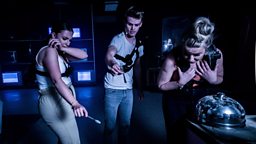How we made Don’t Scream
Don’t Scream is a nerve-shredding reality game show, which sees a team of three best mates work a night shift from hell in an old and disused shopping centre.
At the start of the shift the team is given a cash sum of £5000, but in order to hold onto the money, they’ll need to hold onto their nerve. Because every time they scream they will lose £100.
But it won’t be easy to stay cool for the cash. The shopping centre has been rigged with shocks, jumps, scares and surprises – we wanted to make this a hair-raising game show with shocks around every corner.

Fears vs Phobias
Our aim with this show was to make people scream. But we needed it to be fun rather than traumatic. We knew our cast of contestants would be key to success.
After sending out an open invite to take part in the show we had a huge amount of applications from groups of friends who all thought it would be a fun thing to do and that they had a good chance of staying cool for cash. We were looking for a group of friends who would be entertaining to watch but it was important that we could attempt to make them scream safely.
We put our shortlisted applicants through an assessment with a qualified psychologist. Firstly this was to make sure they were suitable for the show but also to determine some facts about their fears and phobias.
A phobia is a type of anxiety disorder defined by a persistent and excessive fear of an object or situation. The phobia typically results in a rapid onset of fear. Therefore it was vital we identified what phobias they had as it was important to avoid using them as a way to make them scream.
Fear is a feeling induced by perceived danger or threat which causes a change in behaviour, such as fleeing, hiding, or screaming.
The psychologist had experience in this field and could help us play the right level of jump and scare. They interviewed the contestants before filming and was present on the filming day to help and advise us and also support the contestants if needed. They were also available to the contestants after filming.
Creating Fear
Fear is personal – something that scares one person might not work on another. We tested all our scares out repeatedly to craft them very precisely for the individuals playing the game. The most frightening images and feelings are those created by the individuals’ minds. We knew in order to scare them the build-up would be just as important as any scares themselves, so we wanted to create an atmosphere of fear to allow people to fill in their own blanks.
For the set we used a disused shopping centre in Aldershot. It was fantastic! They had kept it exactly as it was left when it was shut down seven years ago. We called it Silent Oaks and built three sets – Womenswear, Βι¶ΉΤΌΕΔ & Electrical and Kids-Zone. All rigged with some brilliant jumps and scares that we had spent months developing with our scare team – a team made up of people from the magic circle and immersive theatre experts – these guys had the ability to do some brilliantly creative stuff.
On the day of the record we were observed and advised by independent adjudicators, a psychologist, a paramedic and a team of experienced scare designers to help us achieve the jumpiest and scariest game possible.
Tracking Screams
The contestant’s screams were identified by a system we developed with experienced sound engineers named D.I.A.N.A (Digital Involuntary Audio Noise Analysis).
This clever system was able to count the times each contestant made an involuntary noise above a certain set level and intensity with each scream being independently verified. They were also tested to ensure it was fair for both men and women who may have different pitches of scream. This system allowed us to identify the difference between a scream and someone shouting to a friend, for instance. We were only interested in the screams.

Could you stay quiet for Β£5000?
Yung Filly explains how you play Don't Scream
